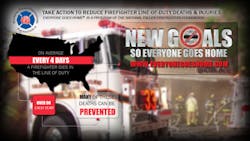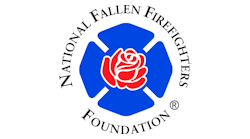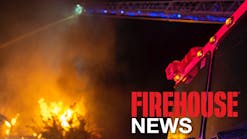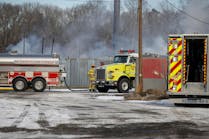NFFF New Goals Campaign: Company Officer Development
Keith is a company officer at a volunteer fire department on the East Coast. As with most departments, there were minimum requirements Keith had to meet to become an officer. As he moved from the backstep to the front seat, Keith realized just meeting those requirements didn’t really prepare him to take over such a crucial role in the fire service.
For promotion, Keith’s firehouse simply followed the guidelines established by the local government. It required completion of coursework and length of service at each operational rank. Both Keith and the senior leadership of his department realized this wasn’t enough.
“Up until very recently the officer development program within our department was informal. The challenges in moving from firefighter to officer without a defined training process in place are immense and under-appreciated,” Keith explained.
The lack of training opportunities for officer development is not the fault of the firefighters moving up. We shouldn’t forget that every department – even stations within large departments – operates differently. A structured chain of command, training requirements and officer development are not universal.
A problem for many new officers aren’t prepared for is the transition from “buddy to boss.” Firefighters often test their officers to see what they can get away with. There will be times when a new officer has to draw a line in the sand. Crossing over that line can jeopardize relationships with friends. Effective leadership for a new officer means knowing more than protocols and procedures. An effective company officer has to always keep in mind the safety and well-being of their crew. It’s their ultimate responsibility.
This is why an understanding of the Life Safety Initiatives is crucial to the development of a Company Officer. The officer sets the tone for safety and accountability through words and actions. It must be a priority in the culture of firefighting.
In Keith’s case, his department embraces the Life Safety Initiatives.
“Safety is of utmost importance at all times. I ensure training is conducted across the various disciplines on a routine basis,” Keith confirmed.
While Keith’s department requires annual physicals for all members in order to remain active, Keith admits it has been difficult for him to address wellness and fitness issues with his fellow firefighters. “I don't feel it’s necessarily my position to comment on this and other ideas such as a healthy diet as a volunteer officer. It has been hard to find the balance between being intrusive and being an officer concerned about the physical health of those on my crew,” he explained.
I’m certain Keith is not alone in this sentiment. We need to provide guidance for officers to talk with their crews and colleagues about the importance of a healthy diet, physical activity, not smoking and drinking only in moderation and when appropriate. We can’t lose site of the fact that most firefighters are dying in the line-of-duty each year because of heart attacks and strokes. Things that are mostly preventable.
Officers can start with something as simple as planning healthy meals at the firehouse. There are also plenty of weight and physical fitness campaigns such as “biggest loser,” counting steps walked daily, and preparing for 5K runs and Stair Climbs in the community. Company officers can remind others that taking responsibility for their health and wellness not only benefits themselves, but also their families and their fellow firefighters.
Whether a department is large or small, urban or rural, structural or wildland, it is on the shoulders of company officers or crew bosses to see to it that every incident is managed effectively.
Fortunately for Keith he took the time to seek out others who were more than willing to give him advice and support. “I had numerous mentors with years of officer experience to guide me in the right direction,” he explained. He knows of others who have done the same and have been successful.
Keith’s own experience helped lead his department to require a formal training process for the promotion to Company Officer. It includes written and practical tests and a panel interview.
“This is a much more effective means to determine when a firefighter is ready to tackle the responsibilities of a Company Officer,” he says.
Equipped with more education resources, thorough training and competent mentors, the fire service can help candidates become better officers. Keith’s experience helped him fully understand the support needed for new and current company officers. “Getting promoted has to be about much more than just checking boxes. We must groom new leaders so they’re able to face the tests that can mean the difference between success and failure on the fireground. Tests that can even mean the difference between life and death for you and your crew.”
For more on the NFFF New Goals Campaign, go to http://www.firehouse.com/nfff-new-goals.
SIDEBAR
Resources for preparing Company Officers and reducing LODDs
The National Fallen Firefighters Foundation is producing an online program to help company officers understand and practice the fundamentals of health and safety in their leadership role. The self-paced program addresses personal commitment to health and safety, “buddy to boss” transition, SOP enforcement and crew resource management. It is designed to support the existing fire officer education and training system by providing specific, credible information about the health and safety aspects of the company officer’s responsibilities.
For new officers, this training can be part of navigating the transition from firefighter to Company Officer. For current officers, this training may be undertaken at any time during their tenure.
For more information about the 16 Life Safety Initiatives and Company Officer Development go to www.everyonegoeshome.com.
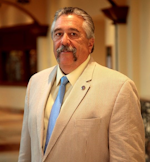
Ronald Siarnicki | National Fallen Firefighters Foundation
Fire Chief Ronald Jon Siarnicki began his career as a firefighter with the Prince George's County Fire/EMS Department in 1978 and with 24 years of fire, rescue, and emergency medical services operational experience, he has progressed through the ranks to Chief of the Department. In this position he served as the Chief Executive Officer responsible for the fire, rescue and emergency medical services of Prince George's County, Maryland. In July of 2001, Chief Siarnicki retired from the Prince George?s County Fire/EMS Department to take the position of Executive Director of the National Fallen Firefighters Foundation in July of 2001. He is a graduate of the Masters Program, School of Management and Technology, at the University of Maryland, University College, College Park, Maryland and has a Bachelor of Science Degree in Fire Science Management from UMUC. He is a certified Fire Officer IV, Fire Fighter Level III, and State Emergency Medical Technician. He has served as a UMUC faculty member for the Fire Science Curriculum since 1997.
